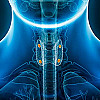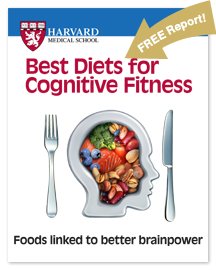Recent Blog Articles

How — and why — to fit more fiber and fermented food into your meals

Tick season is expanding: Protect yourself against Lyme disease

What? Another medical form to fill out?

How do trees and green spaces enhance our health?

A muscle-building obsession in boys: What to know and do

Harvard Health Ad Watch: New drug, old song, clever tagline

Concussion in children: What to know and do

What color is your tongue? What's healthy, what's not?

Your amazing parathyroid glands

When — and how — should you be screened for colon cancer?
Child & Teen Health Archive
Articles
Emergencies and First Aid - How to Make a Sling
How to Make a Sling
1. To make a sling, cut a piece of cloth, such as a pillowcase, about 40 inches square. Then cut or fold the square diagonally to make a triangle. Slip one end of the bandage under the arm and over the shoulder. Bring the other end of the bandage over the other shoulder, cradling the arm. | 2. Tie the ends of the bandage behind the neck. Fasten the edge of the bandage, near the elbow, with a safety pin. |
Collar and Cuff Sling |
Use a collar and cuff sling for a suspected fracture of the collarbone or elbow when a triangular sling is not available. Wrap a strip of sheet, a pants leg, or pantyhose around the wrist and tie the ends behind the neck. |
Emergencies and First Aid - How to Splint a Fracture
How to Splint a Fracture
For a lower arm or wrist fracture (left), carefully place a folded newspaper, magazine, or heavy piece of clothing under the arm. Tie it in place with pieces of cloth. A lower leg or ankle fracture (right) can be splinted similarly, with a bulky garment or blanket wrapped and secured around the limb. A person with a hip or pelvis fracture should not be moved. If the person must be moved, the legs should be strapped together (with a towel or blanket in between them) and the person gently placed on a board, as for a back injury. | |
Emergencies and First Aid - Heimlich Maneuver on an Adult
Heimlich Maneuver on an Adult
| ||||
Emergencies and First Aid - Heimlich Maneuver on a Child
Heimlich Maneuver on a Child
| ||
Emergencies and First Aid - Heimlich Maneuver on an Infant
Heimlich Maneuver on an Infant
| ||||
Children’s Fears and Anxieties
A child's world is full of dangers, real and imaginary, that many adults forget they ever experienced. Most childhood fears are normal, temporary, and eventually outgrown, but studies still show that anxiety disorders are among the most common childhood psychiatric conditions. In a high proportion of cases, it turns out that the symptoms of an adult anxiety disorder first appeared in childhood, so treatment of abnormal childhood anxiety is not only important for its own sake but may help prevent adult disorders.
Children's minds and emotions are constantly changing and developing, and they do not all develop at the same rate, so it is not always easy to distinguish normal fears from those that require special attention. Newborns typically fear falling and loud noises. Fear of strangers begins as early as six months and persists until the age of two or three. Preschool children usually fear being separated from their parents; they may also be afraid of large animals, dark places, masks, and supernatural creatures. Older children may worry about death in the family, failure in school, and events in the news such as wars, terrorist attacks, and kidnappings. Adolescents have sexual and social anxieties and concerns about their own and the world's future. These anxieties become a problem only if they persist and cause serious distress, destroy family harmony, or interfere with a child's development or education.
Treating ear infections in children
If your child is rubbing his ear, should you run to the doctor's office to demand antibiotics? Probably not. Your child may simply have fluid in the ear and not the classic ear infection that parents and children dread.
Middle Ear Fluid (Otitis Media with Effusion)
Over 2 million American children experience fluid in the middle ear each year, often following a cold or an acute ear infection. The condition is also called a silent ear infection because many children have no symptoms. Some children, though, may rub their ear or experience mild pain, sleep disturbances, unexplained clumsiness, muffled hearing, or delays in language and speech development. The condition may be diagnosed during a routine well-child visit with the use of a pneumatic otoscope, which allows the doctor to see how easily the eardrum moves.
Possible suicide risk in children treated with SSRI’s—TheFamily Health Guide
Possible suicide risk in children treated with SSRI's
No one wants his or her child to be unhappy, let alone clinically depressed. So when a diagnosis of childhood depression surfaces parents may be tempted to go along with a doctor's suggestion or even ask the doctor for a prescription of antidepressants for the child. But what is supposed to help may actually end up causing harm.
The Food and Drug Administration (FDA) has issued a warning of a possible suicide risk in children and adolescents treated with a certain class of antidepressants that includes Prozac and Paxil. The available data from clinical trials suggest selective serotonin reuptake inhibitors (SSRIs) may be associated with an increase in suicidal behaviors and attempts shortly after the start of treatment. Although Prozac is the only SSRI known to have a benefit in children and approved for such use by the FDA, other drugs in this class may be prescribed "off-label" at a physician's discretion.
Bad backs and backpacks
While going to and from school many kids these days look like they have the weight of the world on their shoulders. Although it might not be quite so heavy, some kids actually do carry around a lot of weight in their backpacks. These heavy loads place stress on the spine and shoulders of children, causing muscle strain and fatigue. For some kids the aches and pains are bad enough to seek medical attention. Too much weight can also lead to bad habits such as poor posture and excessive slouching.
Unfortunately, doing homework and being prepared in class means carrying books back and forth between school and home. You can help your child lighten the load by teaching him or her organizational skills. By using folders for individual subjects your child can bring home just the work he needs for the day as opposed to lugging everything home. At school, encourage your child to take frequent trips in between classes to his or her locker to replace books.
Recent Blog Articles

How — and why — to fit more fiber and fermented food into your meals

Tick season is expanding: Protect yourself against Lyme disease

What? Another medical form to fill out?

How do trees and green spaces enhance our health?

A muscle-building obsession in boys: What to know and do

Harvard Health Ad Watch: New drug, old song, clever tagline

Concussion in children: What to know and do

What color is your tongue? What's healthy, what's not?

Your amazing parathyroid glands

When — and how — should you be screened for colon cancer?
Free Healthbeat Signup
Get the latest in health news delivered to your inbox!
Sign Up








